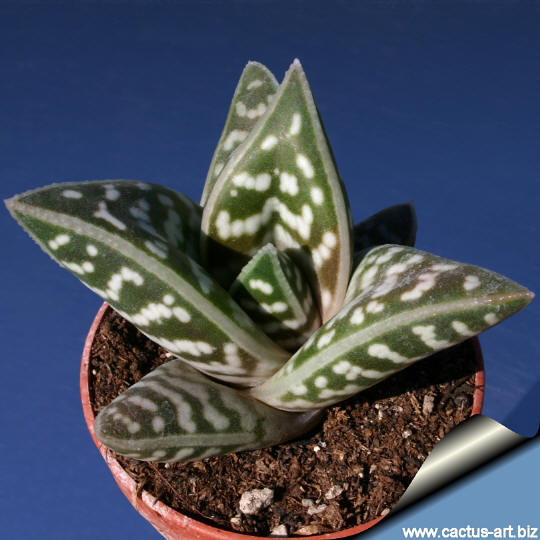|
|
|
Family: Asphodelaceae
Scientific name:
Aloe variegata L
Origin: Indigenous to the dry parts
of Western South Africa (Cape Provinces, Namaqualand, Karoo and Orange
Free State) and southern Namibia.
Common Names include: Partridge Breast Aloe, Tiger Aloe
A. variegata may be confused with two Aloes that are
found in Namibia (Aloe dinteri and Aloe sladeniana).
Synonyms:
- Aloe variegata var. haworthii
- Aloe punctata
- Aloe ausana
|
|

A young specimen.
|
|
|
|
Description: Plants are stemless and form
groups of a few rosettes 30 cm tall, around to20-30 cm wide. It has
18-24 smooth dark-green or brown leaves arranged in three ranks, each
leaf is 10-15 cm long and 3-6 cm broad, irregularly variegated
alternately dark green and whitish, a distinctive keel is present on the
lower leaf surface. The leaf margins are sporadically armed with tiny
white teeth.
Flowers: The flowers are relatively large and hang loosely from
the inflorescence (a 20-30 cm height raceme) they are usually orange
with green edges. (but may vary in colour from a dull-pink to red and
seldom yellow ) Blooms in winter or early spring. offsets being readily
formed. |
|
Cultivation: A. variegata is easy to grow in light shade and
make a great, almost no care houseplant although, without bright enough
lighting can become leggy and pale but looks it's best when grown in
full sun.. Its main growing periods are spring and Autumn. Keep
relatively dry, careful watering is required, as it is prone to rot if
overwatered, especially in the winter months.. Frost protection is
required (but plant can tolerate -7°C for short period). Thrives in
medium to large sized pots and need a drained soil.
Maintenance: Removal of old flower
stalks; During the
winter months, the plants should be grown cool to initiate flower
development (about 5-10°C ).
Reproduction: Usually via offsets
(cuttings), it is also possible the propagation from seed which
germinates easily if sown in well drained soil and covered lightly with
fine sand. Seedlings grow fast, reaching flowering size in three to four
years. Seeds
must be sown as fresh as possible. Fresh seeds
germinate
quickly at 18°C.

 |
|